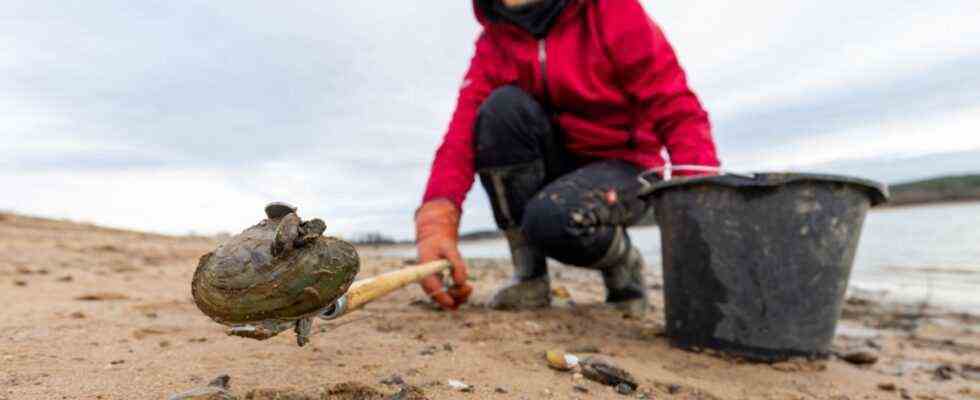Every day a little more water runs out of the Rothsee. The sinking water level brings whole mussel carpets to the daylight. Volunteers have been collecting thousands of native mussels for weeks in order to bring them deeper into the lake and into the saving water. Otherwise they would die in the winter temperatures. What remains are the much smaller triangular clams – and that is on purpose. The mussels are causing massive problems in the reservoir, about 30 kilometers south of Nuremberg. They are already spreading so strongly on the lake floor that other mussels are deprived of their habitat, as Manuel Philipp from the Nuremberg Water Management Office explains. That is why the authority lowers the water level of the lake to six meters over several weeks every year. Two to three cool nights with freezing temperatures were enough to contain the population, says Philipp.
The Rothsee may be a special case, but experts also observe large populations of immigrated triangular mussels elsewhere. In particular, the quagga mussel (Dreissena rostriformis bugensis), which belongs to the triangular mussel family, has been spreading rapidly in Germany for several years. “The mussels occur wherever there is shipping,” says Franz Schöll from the Federal Institute for Hydrology. The quagga mussel originally comes from the mouth of the Black Sea and was probably brought in by shipping. According to the Federal Environment Agency, it has now spread from Lake Constance to northern Germany.
In some cases it even displaces its relative, the zebra mussel (Dreissena polymorpha), which also belongs to the three-sided mussels. This was originally at home in Central Europe and was pushed back in the last Ice Age, but has been spreading again via shipping for several decades. “In general, the quagga mussel seems to be more competitive, as its occurrence is usually associated with a decline in the zebra mussel,” says Andreas Dobler from the Coordination Office for Mussel Protection at the Technical University of Munich. An example of this is the Main-Danube Canal, in which it has been the most common type of mussel since 2008, which until then was the zebra mussel.
The new species also has a positive effect
The quagga mussel has also been spreading in Lake Constance since 2016 – and at a rapid pace. Three years after the first find, it had already conquered the entire Lake Constance, as Dominic Hahn from the Bund Naturschutz Baden-Württemberg says. He views the spread of the triangular mussels with some concern. These could make the endangered domestic large mussels in dispute for food. In addition, the larvae could invade water supply systems, block pumps and cause serious technical problems. But there are also positive effects: “The number of wintering waterfowl has increased on Lake Constance,” says Hahn. Tufted duck, pochard and coot in particular like to help themselves at the mussel banks.
According to Dobler, the spread of the triangular mussels can hardly be stopped because the larvae could attach themselves to hard surfaces. “All it takes is a pleasure craft or something similar to be brought from one body of water to the next to bring the mussel in.” The only possibility would be to always disinfect boats, surf boards, diving equipment and the like and let them dry for a long time. But especially in the private sector, this would be utopian without a legal basis and strict controls.
And even in the Rothsee, the annual lowering of the water level can only reduce the population. Because with the water from the Main-Danube Canal, new triangular mussels keep coming up.

